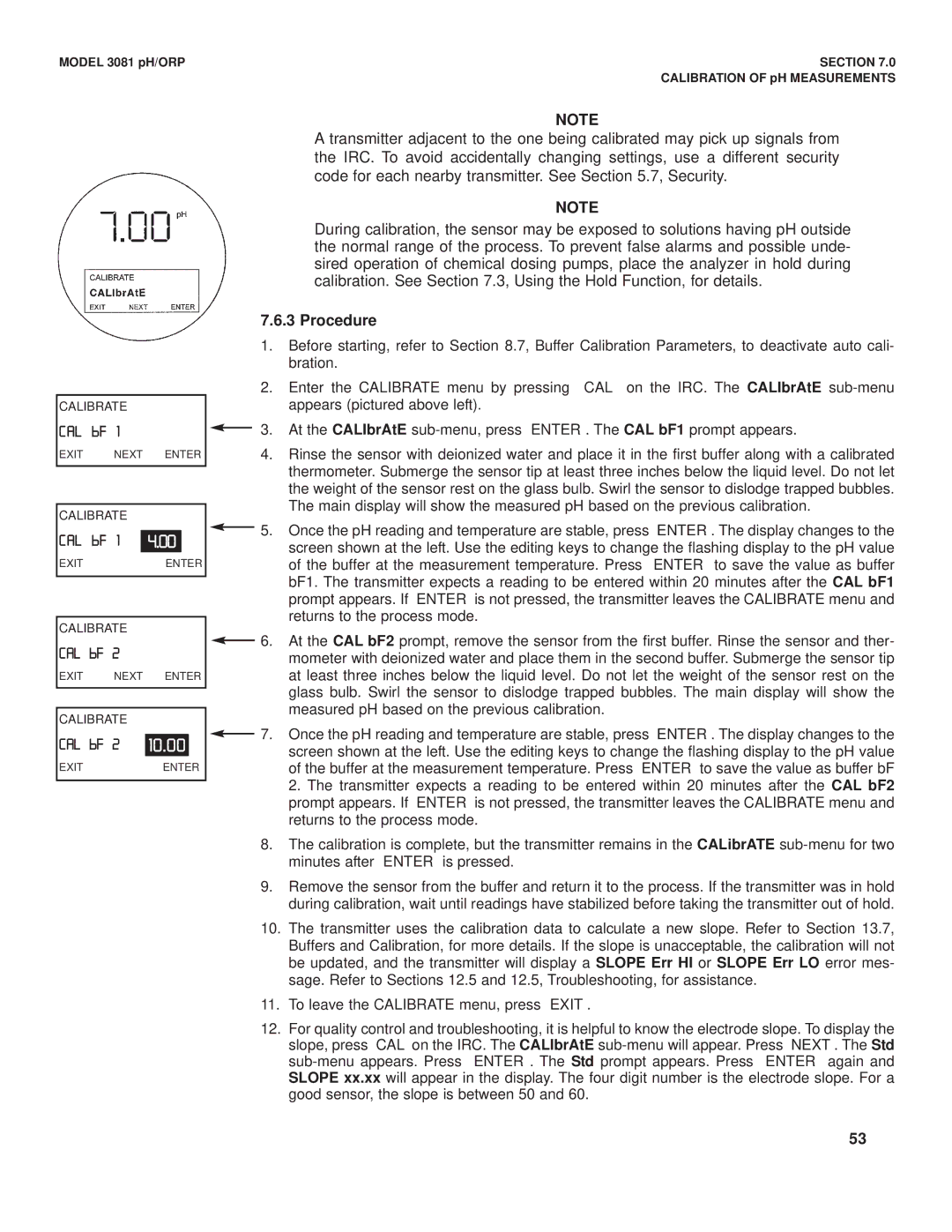
MODEL 3081 pH/ORP | SECTION 7.0 |
| CALIBRATION OF pH MEASUREMENTS |
CALIBRATE
CAL bF 1
EXIT NEXT ENTER
CALIBRATE
CAL bF 1 | 4.00 |
|
EXIT | ENTER | |
CALIBRATE
CAL bF 2
EXIT NEXT ENTER
CALIBRATE
CAL bF 2 | 10.00 |
|
EXIT | ENTER | |
NOTE
A transmitter adjacent to the one being calibrated may pick up signals from the IRC. To avoid accidentally changing settings, use a different security code for each nearby transmitter. See Section 5.7, Security.
NOTE
During calibration, the sensor may be exposed to solutions having pH outside the normal range of the process. To prevent false alarms and possible unde- sired operation of chemical dosing pumps, place the analyzer in hold during calibration. See Section 7.3, Using the Hold Function, for details.
7.6.3 Procedure
1.Before starting, refer to Section 8.7, Buffer Calibration Parameters, to deactivate auto cali- bration.
2.Enter the CALIBRATE menu by pressing CAL on the IRC. The CALIbrAtE
3. At the CALIbrAtE
4.Rinse the sensor with deionized water and place it in the first buffer along with a calibrated thermometer. Submerge the sensor tip at least three inches below the liquid level. Do not let the weight of the sensor rest on the glass bulb. Swirl the sensor to dislodge trapped bubbles. The main display will show the measured pH based on the previous calibration.
![]() 5. Once the pH reading and temperature are stable, press ENTER . The display changes to the screen shown at the left. Use the editing keys to change the flashing display to the pH value of the buffer at the measurement temperature. Press ENTER to save the value as buffer bF1. The transmitter expects a reading to be entered within 20 minutes after the CAL bF1 prompt appears. If ENTER is not pressed, the transmitter leaves the CALIBRATE menu and returns to the process mode.
5. Once the pH reading and temperature are stable, press ENTER . The display changes to the screen shown at the left. Use the editing keys to change the flashing display to the pH value of the buffer at the measurement temperature. Press ENTER to save the value as buffer bF1. The transmitter expects a reading to be entered within 20 minutes after the CAL bF1 prompt appears. If ENTER is not pressed, the transmitter leaves the CALIBRATE menu and returns to the process mode.
![]() 6. At the CAL bF2 prompt, remove the sensor from the first buffer. Rinse the sensor and ther- mometer with deionized water and place them in the second buffer. Submerge the sensor tip at least three inches below the liquid level. Do not let the weight of the sensor rest on the glass bulb. Swirl the sensor to dislodge trapped bubbles. The main display will show the measured pH based on the previous calibration.
6. At the CAL bF2 prompt, remove the sensor from the first buffer. Rinse the sensor and ther- mometer with deionized water and place them in the second buffer. Submerge the sensor tip at least three inches below the liquid level. Do not let the weight of the sensor rest on the glass bulb. Swirl the sensor to dislodge trapped bubbles. The main display will show the measured pH based on the previous calibration.
![]() 7. Once the pH reading and temperature are stable, press ENTER . The display changes to the screen shown at the left. Use the editing keys to change the flashing display to the pH value of the buffer at the measurement temperature. Press ENTER to save the value as buffer bF
7. Once the pH reading and temperature are stable, press ENTER . The display changes to the screen shown at the left. Use the editing keys to change the flashing display to the pH value of the buffer at the measurement temperature. Press ENTER to save the value as buffer bF
2. The transmitter expects a reading to be entered within 20 minutes after the CAL bF2 prompt appears. If ENTER is not pressed, the transmitter leaves the CALIBRATE menu and returns to the process mode.
8.The calibration is complete, but the transmitter remains in the CALibrATE
9.Remove the sensor from the buffer and return it to the process. If the transmitter was in hold during calibration, wait until readings have stabilized before taking the transmitter out of hold.
10.The transmitter uses the calibration data to calculate a new slope. Refer to Section 13.7, Buffers and Calibration, for more details. If the slope is unacceptable, the calibration will not be updated, and the transmitter will display a SLOPE Err HI or SLOPE Err LO error mes- sage. Refer to Sections 12.5 and 12.5, Troubleshooting, for assistance.
11.To leave the CALIBRATE menu, press EXIT .
12.For quality control and troubleshooting, it is helpful to know the electrode slope. To display the slope, press CAL on the IRC. The CALIbrAtE
53
